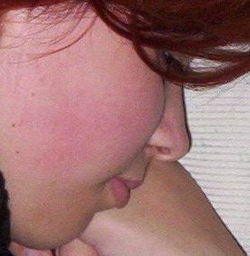Cheek
| Cheek | |
|---|---|
 |
|
| Girl with prominent (puffy) cheeks. | |
| Latin | buccae |
| Artery | buccal artery |
| Nerve | buccal nerve, buccal branch of the facial nerve |
| MeSH | Cheek |
Cheeks (Latin: buccae) constitute the area of the face below the eyes and between the nose and the left or right ear. It is also called the jowls.
It is fleshy in humans[1] and other mammals, the skin being suspended by the chin and the jaws, and forming the lateral wall of the human mouth, visibly touching the cheekbone below the eye.
In vertebrates, markings on the cheek area (malar stripes/spots/...), particularly immediately beneath the eye, often serve as important distinguishing features between species or individuals.
"Buccal" means relating to the cheek. In humans, the region is innervated by the buccal nerve.
The inside of the cheek (forming part of the mouth cavity) is lined with a mucous membrane. It is the most common location from which a DNA sample can be taken (during a cheek swab).
The cheeks are covered externally by hairy skin, and internally by stratified squamous epithelium. This is mostly smooth, but may have aborally directed papillae (e.g: ruminants). The mucosa is supplied with secretions from the Buccal glands, which are arranged in superior and inferior groups. In carnivores, the superior buccal gland is large and discrete: the Zygomatic gland. During mastication (chewing), the cheeks and tongue between them serve to keep the food between the teeth.
See also
- Cheek augmentation
- Blushing
- Erythema infectiosum
- Tongue-in-cheek
- Zygomatic bone
References
|
||||||||||||||||||||||
|
||||||||||||||||||||||||||||||||||||||
| This anatomy article is a stub. You can help Wikipedia by expanding it. |